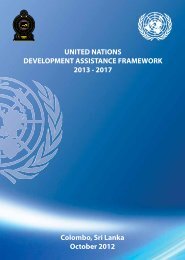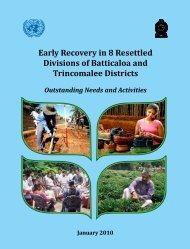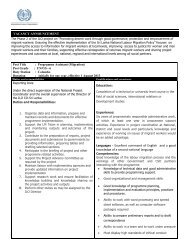Sri Lanka Human Development Report 2012.pdf
Sri Lanka Human Development Report 2012.pdf
Sri Lanka Human Development Report 2012.pdf
Create successful ePaper yourself
Turn your PDF publications into a flip-book with our unique Google optimized e-Paper software.
The length of national, provincial and local roads has<br />
improved marginally over the years. 254 Agricultural,<br />
local and gravel roads have particularly increased in more<br />
deprived regions such as Sabaragamuwa. Roads connecting<br />
the main towns have not changed much in terms of length,<br />
but investments have been made in improving their<br />
quality.<br />
Investment in road infrastructure has increased significantly<br />
from Rs. 18.8 billion in 2005 to Rs. 107.8 billion in<br />
2010. Out of the 2010 investment, 72 percent has been<br />
on improving, upgrading, rehabilitating and maintaining<br />
roads. 255 Further, several projects have been initiated<br />
to connect the main economic centres by expressways,<br />
absorbing about 23 percent of expenditures. 256 One new<br />
road is the recently opened Colombo-Galle highway, the<br />
first of its type in the country.<br />
While <strong>Sri</strong> <strong>Lanka</strong>’s road infrastructure is in relatively good<br />
condition, poor transport conditions in terms of road<br />
quality and the availability of transport facilities hold back<br />
rural enterprises. The World Bank identified this as the<br />
top hindrance they face. A survey found that more than<br />
46 percent of respondents in rural areas said that transport<br />
was an obstacle to doing business. Road quality is poorest<br />
in the Northern Province followed by Uva Province.<br />
The survey also reported that only 20 percent of<br />
urban manufacturers said that transport was a severe<br />
constraint. But traffic congestion and worker absenteeism<br />
stemming from the unavailability of transportation were<br />
identified as critical factors influencing productivity. 257<br />
The examination of congestion in urban areas could<br />
consider impacts like these, along with possible solutions.<br />
The time to access economic and administrative services<br />
varies across districts (Table A26). Those with a high<br />
concentration of estates and/or lagging development,<br />
experience longer distances and times. For a person in<br />
Nuwara Eliya, which has many estates, on average it takes<br />
about 14 minutes to reach a bus halt; the nearest would<br />
be about two kilometres away. The closest local authority<br />
is about 52 minutes away, the nearest local administrative<br />
authority about 70 minutes away, and the post office about<br />
22 minutes away. A person in Colombo can reach a bus halt<br />
in about 8 minutes, and the other services are accessible in<br />
under 30 minutes. Longer times to access services in some<br />
areas may be due to poor quality roads and geography. The<br />
estates, for instance, are located in hilly terrain.<br />
Access to finance<br />
Since capital is a major factor of production, businesses<br />
should be able to quickly and cheaply access it through an<br />
efficient financial system, and be able to use it in the most<br />
productive manner.<br />
Formal financial services in <strong>Sri</strong> <strong>Lanka</strong> have high outreach.<br />
A 2008 study found that 82.5 percent of sample<br />
households have used formal financial institutions,<br />
while 47 percent have turned to loan services, mostly for<br />
livelihood activities. There are, however, clear disparities<br />
in the utilization of financial services. Only 75.2 percent<br />
of households in North Western Province have used<br />
them, along with 76.5 percent in Uva Province and 76.2<br />
percent in Eastern Province. In North Central Province,<br />
89.8 percent of households have used financial services. 258<br />
It takes the average <strong>Sri</strong> <strong>Lanka</strong>n about 25 minutes to get<br />
to a financial facility, but access time is over 35 minutes<br />
for the districts of Moneragala, Badulla and Ampara. It<br />
is under 15 minutes for Colombo and Gampaha. For all<br />
other districts, access time is about 20-25 minutes (Table<br />
A26).<br />
Financial service issues faced by enterprises vary across<br />
urban and rural areas, and by types of investment. A<br />
World Bank study found that both the cost of and access<br />
to finance are major constraints for rural enterprises, but<br />
only the cost of finance is an issue for urban ones. Over<br />
one-half of surveyed rural enterprises cited the constraints<br />
of current financial services on expanding or operating<br />
their business. Of this number, 60 percent identified high<br />
interest and 50 percent tedious loan procedures as severe<br />
problems. 259<br />
Despite the high outreach of formal financial institutions,<br />
the share of formal finance in total financing is low for<br />
92<br />
sri lanka <strong>Human</strong> <strong>Development</strong> report 2012






